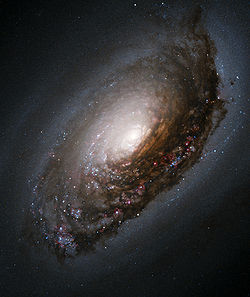- Black Eye Galaxy
-
Black Eye Galaxy[1] 
The Black Eye Galaxy (M64) Observation data
Epoch J2000Constellation Coma Berenices[2] Right ascension 12h 56m 43.7s[3] Declination +21° 40′ 58″[3] Apparent dimension (V) 10.71 × 5.128 moa[4] Apparent magnitude (V) 9.36[3] Characteristics Type (R)SA(rs)ab, HIISy2 Astrometry Helio Radial velocity 408 ± 4[3]km/s Redshift 0.001361 ± 0.000013[3] Galactocentric Velocity 400 ± 4 km/s Distance 24 ± 2 Mly (7.4 ± 0.61 Mpc) Other designations Database references SIMBAD Search M64 data See also: Galaxy, List of galaxies The Black Eye Galaxy (also called Sleeping Beauty Galaxy; designated Messier 64, M64, or NGC 4826) was discovered by Edward Pigott in March 1779, and independently by Johann Elert Bode in April of the same year, as well as by Charles Messier in 1780. It has a spectacular dark band of absorbing dust in front of the galaxy's bright nucleus, giving rise to its nicknames of the "Black Eye" or "Evil Eye" galaxy. M64 is well known among amateur astronomers because of its appearance in small telescopes. It is a spiral galaxy in the Coma Berenices constellation.
General information
At first glance, M64 seems to be a fairly normal spiral galaxy. As in the majority of galaxies, all of the stars in M64 are orbiting in the same direction, clockwise as seen in the Hubble image.
However, recent detailed studies have led to the remarkable discovery that the interstellar gas in the outer regions of M64 rotates in the opposite direction from the gas and stars in the inner regions. The inner region has a radius of only approximately 3,000 light-years, while the outer section extends another 40,000 light-years. This pattern is believed to trigger the creation of many new stars around the boundary separating the two regions.
A collision of two galaxies has left a merged star system with an unusual appearance as well as bizarre internal motions. Astronomers believe that the oppositely rotating gas arose when M64 absorbed a satellite galaxy that collided with it, perhaps more than one billion years ago. Active formation of new stars is occurring in the shear region where the oppositely rotating gases collide, are compressed, and contract.
Particularly noticeable in the image are hot, blue young stars that have just formed, along with pink clouds of glowing hydrogen gas that fluoresce when exposed to ultraviolet light from newly formed stars. It is approximately 17 million light years from earth. The small galaxy that impinged on its neighbour has now been almost completely destroyed, its stars either merged with the main galaxy or scattered into space, but signs of the collision persist in the backward motion of gas at the outer edge of M64.
References
- ^ J. L. Tonry, A. Dressler, J. P. Blakeslee, E. A. Ajhar, A. B. Fletcher, G. A. Luppino, M. R. Metzger, C. B. Moore (2001). "The SBF Survey of Galaxy Distances. IV. SBF Magnitudes, Colors, and Distances". Astrophysical Journal 546 (2): 681–693. arXiv:astro-ph/0011223. Bibcode 2001ApJ...546..681T. doi:10.1086/318301.
- ^ R. W. Sinnott, ed (1988). The Complete New General Catalogue and Index Catalogue of Nebulae and Star Clusters by J. L. E. Dreyer. Sky Publishing Corporation/Cambridge University Press. ISBN 0-933-34651-4.
- ^ a b c d e f g h i "NASA/IPAC Extragalactic Database". Results for NGC 4826. http://nedwww.ipac.caltech.edu/. Retrieved 2006-11-06.
- ^ a b "Object query : M64". SIMBAD. Centre de Données astronomiques de Strasbourg. http://simbad.u-strasbg.fr/simbad/sim-id?Ident=M64. Retrieved 2008-07-09.
External links
- Messier 64, SEDS Messier pages
- Hubblesite description and high resolution images
- ESA/Hubble images of M64
- APOD for August 2, 2007
- The Black Eye Galaxy on WikiSky: DSS2, SDSS, GALEX, IRAS, Hydrogen α, X-Ray, Astrophoto, Sky Map, Articles and images
- a real photo by Pete Albrecht
Messier objects List M1 · M2 · M3 · M4 · M5 · M6 · M7 · M8 · M9 · M10 · M11 · M12 · M13 · M14 · M15 · M16 · M17 · M18 · M19 · M20 · M21 · M22 · M23 · M24 · M25 · M26 · M27 · M28 · M29 · M30 · M31 · M32 · M33 · M34 · M35 · M36 · M37 · M38 · M39 · M40 · M41 · M42 · M43 · M44 · M45 · M46 · M47 · M48 · M49 · M50 · M51 · M52 · M53 · M54 · M55 · M56 · M57 · M58 · M59 · M60 · M61 · M62 · M63 · M64 · M65 · M66 · M67 · M68 · M69 · M70 · M71 · M72 · M73 · M74 · M75 · M76 · M77 · M78 · M79 · M80 · M81 · M82 · M83 · M84 · M85 · M86 · M87 · M88 · M89 · M90 · M91 · M92 · M93 · M94 · M95 · M96 · M97 · M98 · M99 · M100 · M101 · M102 · M103 · M104 · M105 · M106 · M107 · M108 · M109 · M110See also  Book:Messier objects ·
Book:Messier objects ·  Category:Messier objects
Category:Messier objects  Portal:AstronomyCategories:
Portal:AstronomyCategories:- Spiral galaxies
- Unbarred spiral galaxies
- Coma Berenices constellation
- Messier objects
- NGC objects
- Virgo Supercluster
Wikimedia Foundation. 2010.
